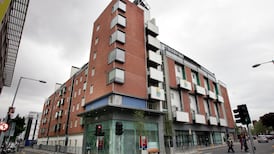The scale of injuries to cyclists as a result of bicycles getting stuck in tram tracks on the Luas lines in Dublin is “a significant public health issue”, according to a new medical study.
A review of cyclists attending the emergency department in St James’s Hospital in Dublin over a two-year period found 48 patients had suffered injuries sustained when their bicycle wheel got caught in the on-road Luas tracks.
The Dublin cycling campaign group said the gap at the Luas tracks “almost perfectly” fits bicycle wheels, with this research showing the need to increase the presence of segregated cycle lanes.
It identified the Luas tracks around College Green as a particular “black spot”, accounting for 46 per cent of all incidents. Stephen’s Lane near Heuston Station and Dawson Street each accounted for one-in-eight accident sites.
READ MORE
The study by a team of researchers found 60 per cent of such patients had suffered a limb fracture with 14 per cent requiring orthopaedic surgery.
Among the most serious injuries was a patient who suffered a broken hip and another who had part of their bicycle embedded in the soft tissue of their thigh.
A third of all injured cyclists sustained some type of head injury, while a quarter of all patients suffered a soft tissue injury.
The study also revealed that 50 per cent of the patients were not wearing a helmet at the time of the incident.
[ Ian O’Riordan: Silence of electric cars presents new danger to cyclistsOpens in new window ]
However, the researchers said the rate of non-wearing of a helmet could be even higher than 50 per cent due to incomplete data on some patients.
More than half of all casualties (56 per cent) sustained an upper limb injury with injuries to the shoulder, hand and elbow the most common, while a third suffered some form of injury to the lower limbs, mostly the knee.
The medical records showed that 54 per cent of the collisions occurred around Dublin city centre during morning and evening rush hours.
Over four-in-ten cyclists were brought to hospital by ambulance from the site of the accident.
Males accounted for 55 per cent of the injured cyclists while 45 per cent were female, while the median age of patients was 30 years.
[ E-scooter crashes cause catastrophic injuries, doctors warnOpens in new window ]
Researchers conducted a retrospective study of cycling injuries linked to the Luas tracks from patients who presented at St James’s emergency department between November 2017 and November 2019.
The findings, which are published in the Irish Journal of Medical Science, showed four cyclists required immediate orthopaedic surgery while three others were admitted for surgery from the fracture clinic.
One of the report’s authors, Olivia Smith, a member of the medical staff in St James’s emergency department, said the audit demonstrates that cycling in and around tram track lines has “inherent dangers”.
The report said the type of injuries sustained by cyclists in such accidents had the potential to not only impact significantly on their day-to-day lives and their employment capability but also at a psychological level on injury outcome and ability to return to work.
Ms Smith said crossing the Luas tracks at a direct 90 degree angle would reduce the risk of a wheel getting caught.
However, she acknowledged that accurate manoeuvring across tram tracks in busy rush hour traffic could prove “challenging or impossible” at traffic-clogged intersections,
The report noted that the filling in of the grooves on the Luas tracks had been suggested but appeared to present engineering difficulties, it also suggested that better signage to heighten awareness among cyclists may need to be considered.
[ Galway: Where the car is still king and ‘glaciers move faster than the council’Opens in new window ]
The study observed that it had gathered data on just one of six adult emergency departments in Dublin city, and that many cyclists may not receive medical attention, or instead visit their GP or a private minor injuries unit.
“Therefore it is possible the number of cyclists involved in tram track cycling injuries in Dublin city may be significantly higher than the number of incidents identified here,” it concluded.
Úna Morrison, public relations officer at Dublin Cycling Campaign, said injuries sustained by cyclists after falling due to Luas tracks are an “issue”.
“From our point of view, anything that causes injury to cyclists is something we need to prevent. We want to ensure that all our cyclists can safely cycle on the road. The way we can ensure this is to continue the expansion of segregated cycle lanes,” she said.
Hazel Chu, Green Party councillor at Dublin City Council and former lord mayor, fell from her bike after its tyres got stuck in a tram track on Dawson Street in summer 2020.
“I fell over and I was trying to get back up when a bus came up behind and started beeping at me. I eventually got back up, but it was hard to get the bike out of the track. It was fine, I was just hurt with some scraping, but I wasn’t seriously injured,” she said.
“This is why we need proper infrastructure for bikes across the city.”













